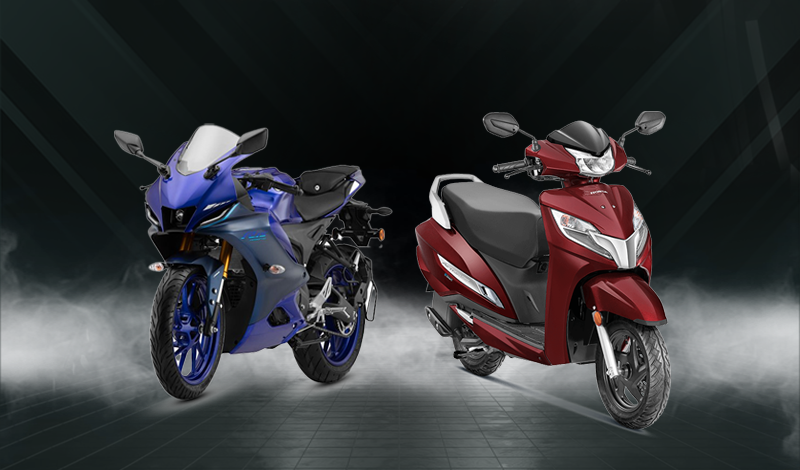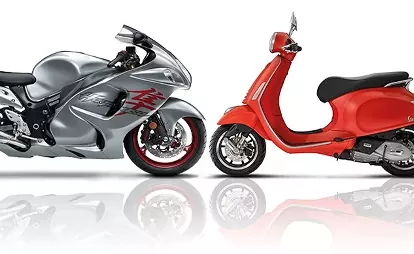When it comes to two-wheelers, many beginners (and even seasoned riders) often wonder: What’s the difference between a motorcycle and a non-gear scooter (also called a scooty)?
This article will break down their key differences, features, advantages, disadvantages, and help you decide which one suits your lifestyle better.

🏍️ 1. What Is a Motorcycle?
A motorcycle is a two-wheeled vehicle powered by an engine, usually ranging from 100cc to 1000cc (or more). It comes with a manual gearbox (usually 4–6 gears) and a clutch lever, which the rider must operate to shift gears.
Common motorcycle types:
- Street bikes
- Sport bikes
- Cruisers
- Adventure bikes
- Cafe racers
Key features:
✅ Manual transmission
✅ Chain or belt-driven
✅ Foot-operated gear shifter
✅ Suitable for long-distance, highways, and rough terrain
🛵 2. What Is a Non-Gear Scooter (Scooty)?
A non-gear scooter, popularly called a scooty (especially in India), is a lightweight two-wheeler with a CVT (Continuously Variable Transmission) — meaning no manual gear shifting is needed. Just twist the throttle, and you’re good to go.
Common scooty types:
- Electric scooters
- Petrol-powered automatic scooters (like Honda Activa, TVS Jupiter)
Key features:
✅ Automatic transmission (CVT)
✅ Lightweight and easy to handle
✅ Flat footboard for storage
✅ Under-seat storage
✅ Best for city commutes

⚙️ 3. Mechanical Differences
| Feature | Motorcycle | Scooty |
|---|---|---|
| Transmission | Manual (clutch + gear shifting) | Automatic (CVT, no clutch or manual gears) |
| Engine position | Larger, higher-performance engine | Small, fuel-efficient engine |
| Frame | Heavier, robust frame | Lightweight, compact frame |
| Wheels | Larger wheels, often 17–18 inches | Smaller wheels, often 10–12 inches |

🏙️ 4. Purpose and Usage
- Motorcycles are built for power, speed, and long rides. They handle rough roads better and are preferred for touring, highway travel, and adventure riding.
- Scooties are made for urban convenience. They are best for short-distance city commuting, quick errands, and are very popular among college students, working professionals, and even older riders.
💸 5. Fuel Efficiency and Maintenance
| Aspect | Motorcycle | Scooty |
|---|---|---|
| Fuel Efficiency | Moderate (40–60 km/l) | High (50–70 km/l) |
| Maintenance | More frequent (due to gears, chains) | Lower, simpler maintenance |
| Cost of Repairs | Higher, especially for premium models | Lower, cheaper spare parts |
🧑✈️ 6. Riding Experience and Skill Level
Motorcycles require more skill to handle, especially when shifting gears smoothly, balancing at low speeds, and maneuvering in traffic. Scooties, on the other hand, are beginner-friendly — just twist and go.
For young riders or new learners, scooties are a perfect entry point. For those seeking adrenaline, speed, and long road trips, motorcycles are the go-to.
🏁 7. Pros and Cons Summary
| Category | Motorcycle | Scooty |
|---|---|---|
| Pros | More power, highway ready, sporty looks, better control at high speeds | Lightweight, easy to handle, fuel-efficient, storage-friendly |
| Cons | Heavier, harder to learn, more expensive to maintain | Lower speed, less stable on highways, smaller tires |
🔑 Final Verdict: Which One Should You Choose?
- Choose a motorcycle if you want to explore long rides, crave power and performance, or plan on touring or off-road adventures.
- Choose a scooty if you need an everyday city commuter that’s easy to handle, light on the pocket, and hassle-free to maintain.
✨ Closing Thoughts
Both motorcycles and scooties have their own unique charm and purpose. The right choice depends on your needs, riding style, and comfort level. Whether you’re zooming down highways or zipping through city streets, both can give you the joy of two-wheeled freedom.

